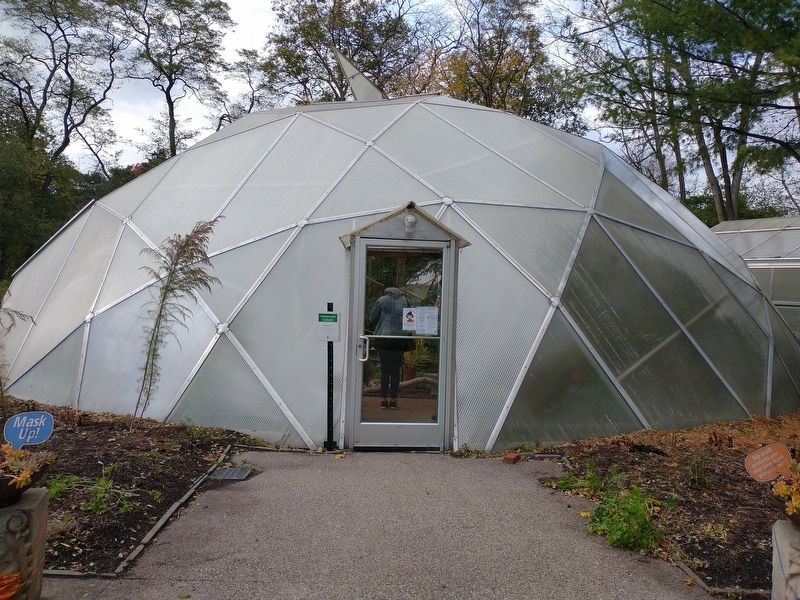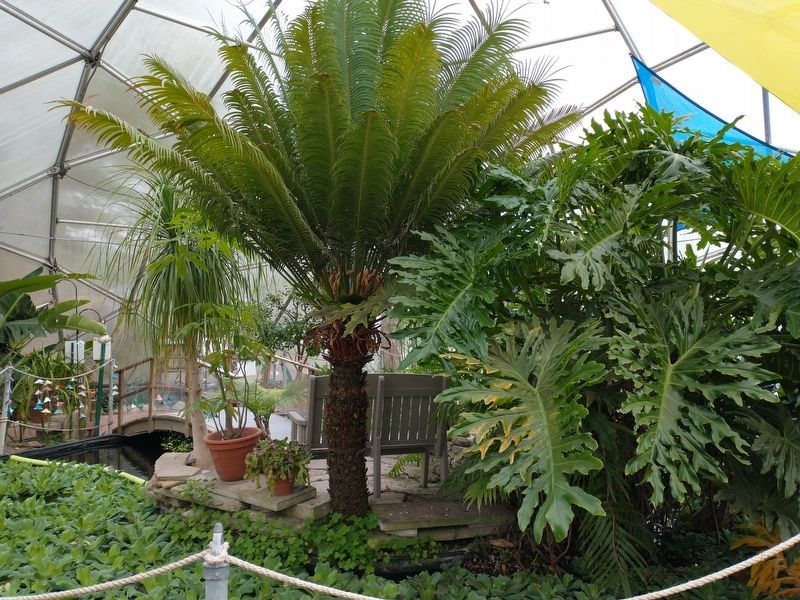Perrysburg in Wood County, Ohio — The American Midwest (Great Lakes)
The Geodesic Biodome
What Is A BioDome:
The Biodome is a solar heated geodesic dome greenhouse. Designed to reduce fossil fuel use and promote local food production. It contains a variety of systems designed to regulate the climate inside the dome and recycle nutrients:
• Spherical Shape: Always faces the sun!
• Aluminum Structure: Provides structural integrity for a lifetime and beyond! Fully-recyclable!
• High-Performance Glazing: 3 layers of rigid polycarbonate. Provides insulation and transmits diffused light for ideal growing conditions.
• Automatic vents: The Biodome moderates its own climate! Thermostat-controlled vents regulate interior temperature and promote air circulation.
• Solar Pond: It is the "furnace” of the Biodome; heats, cools and more. It provides heat storage for year-round performance. The pond is a home for fish, floating plants and a nutrient-rich watering supply.
History Of The Biodome:
Buckminster Fuller was a renowned 20th century architect, engineer, author, designer, inventor, and futurist. In the 1940's he invented the geodesic dome. Domes are thought to be the strongest structures ever devised:
• Uses the natural strength of the geodesic (six-sided) structure. In nature, the geodesic structure is used by honey bees to construct their hives of honeycomb.
• The dome shape offers maximum interior space with minimum space exposed to the outside elements.
In 1976, The Windstar Foundation was founded by John Denver and Thomas Crum, based in the Rocky Mountains near Aspen, Colorado. Its essential purpose was "to inspire and bring forth ideas and models that contribute to a world that works through research, demonstration and education." John Katzenberger, who has been designing and building domes since 1971, founded the Biodome project at the Windstar Foundation, Snowmass, Colorado, in 1982.
Our Dome:
Our dome was designed and built in the spring of 1989 by the Windstar Foundation and John Katzenberger. The dome provides a tropical eco-system that allows us to grow tropical plants and also vegetables out of season. It is managed organically. We strive for a balance with nature, using methods and materials which are of low impact to the environment. The dome is 52' in diameter and 21' tall. 2,206 square feet of pond and growing surface.
• Framework is aluminum pipe and the glazing is a triple walled polycarbonate plastic – has an 'R' value nearly equal to 3 panes of glass.
• The pond is 4' deep and holds 12,000 gallons of water. The pond is a solar collector. It gathers the sun's heat during the day and gives it back at night. It is also a growing medium for fish and aquatic plants and is a source of nutrient rich water, used to irrigate the plants.
• The dome is vented automatically. When the temperature reaches a certain point the 5 top vents and 3 side vents open automatically. When the vents open, a "chimney effect” occurs that draws outside air in at the bottom vents and expels the hotter air through the top vents. During the winter, we provide supplemental heat. During the summer, misters and applied liquid shade are used to help cool the dome.
• The fans are used for air circulation. Circulating air reduces mold, fungal diseases, aids in pest control, plant stamina, additional temperature control, and in some cases pollination.
In 2004 a wind and rain storm blew out some of the polycarbonate panels of the dome. Due to this situation and the fact that the original polycarbonate plastic was deteriorating, a decision was made to reskin the dome and structurally improve the frame. This improvement as well improved the growing medium for its use.
The dome is considered a jewel of The 577 Foundation. Since the beginning, it has been a place to learn about organic growing, an exhibit of a wide variety of plants from all over the world, a seasonal retreat, an interactive indoor garden area, a tropical environment, experimental, and a unique facility for tours for all ages.
Organic Community Gardens
"We hope you will help us preserve these grounds as a center of learning, experimentation and enjoyment… and as an inspiration to understand and preserve our global environment."
- Virginia Secor Stranahan, 1990
The 577 Foundation was originally a country estate for hunter horses. The area around the Dome once was the riding arena. In 1989, this area was transformed into a circle of garden plots. Interested community gardeners were invited to garden organically, learn and share their knowledge with others, and create a pleasant environment for visitors. The Community Gardeners are an important part of The 577 Foundation & their organic garden can serve as an inspiration to future gardeners.
The community gardeners abide by guidelines that are respectful to other gardeners and the many community visitors:
• They attend garden meetings led by The 577 Foundation staff.
• They garden organically!
• A portion of their garden grows produce for the local Food Banks.
• They are responsible for weeding, watering, harvesting, and end of season clean-up of their garden.
Within the Community Gardens is "Virginia's Children's Garden". The interactive garden, developed for children in 2002 is "A space that fosters a natural occurring educational process within the ever-curious child". No better words described the child-like Virginia Stranahan, of whom this garden is in memory. Besides the discovery of a tunnel, stream, dancing/puppet stage and more, focal point is a raised-bed children's garden. School children are taught about organic gardening, grow seeds in the classroom, plant the garden in the spring and assist in tending the garden in the summer. 100% of the produce goes to the Local Food Banks.
What is Organic Gardening?
The simple answer is: Organic gardeners don't use synthetic fertilizers or pesticides. Organic gardeners think in terms of a bigger picture, taking a look at a complete ecosystem that begins with the soil and includes the water supply, insects, wildlife and even people. Soil begins the goal to continually replenish nutrients and organic matter, mimicking as closely as possible nature's cycle of birth, growth, decay and regeneration.
It also means:
• Choosing plants better suited to their site and growing conditions.
• Working to provide the balance of food, water and care plants need throughout their life cycle.
• Realizing that healthy soil means healthy plants, and a plant not stressed will be less prone to problems from pests and diseases.
• When plants become unhealthy, the organic method calls for observation first. When natural forces alone don't provide a solution, we favor the least invasive man made ones.
• We plant companion plants that either deter problems through natural means, or attract beneficial insects to help us with our job.
• We never interrupt the cycle of returning organic matter to the soil.
• We carefully watch to minimize the impact to our environment.
Overall, organic gardening is best described as collaboration with nature to create a space that's beautiful and productive for people, yet still shares it with other creatures. It is a life long philosophy that educates and engages not only us but also our children, realizing that each generation holds a vital link to the stewardship of our planet
Topics. This historical marker is listed in these topic lists: Horticulture & Forestry • Science & Medicine. A significant historical year for this entry is 1976.
Location. 41° 33.921′ N, 83° 37.189′ W. Marker is in Perrysburg, Ohio, in Wood County. Marker is on East Front Street (Ohio Route 65) west of East Boundary Street, on the right when traveling west. Touch for map. Marker is at or near this postal address: 577 E Front St, Perrysburg OH 43551, United States of America. Touch for directions.
Other nearby markers. At least 8 other markers are within walking distance of this marker. Ceramic Dome "Terra Vista" (within shouting distance of this marker); Did's Dig / Log Cabin / Honey Bee Hives (within shouting distance of this marker); The Dairy (Bee Room) / Cow Barn (Pottery Barn) / Solar Thermal Panels (within shouting distance of this marker); Virginia's Garden / The 577 Foundation House House (within shouting distance of this marker); Manabigama Wood Kiln / Compost Corner (within shouting distance of this marker); Hosta Shade Gardens / Bird Blinds (within shouting distance of this marker); Carriage Room (Bookcenter) / Machinery Room (Conference Room) / Cottage (within shouting distance of this marker); 577 Log House (within shouting distance of this marker). Touch for a list and map of all markers in Perrysburg.
Credits. This page was last revised on November 22, 2021. It was originally submitted on November 14, 2021, by Craig Doda of Napoleon, Ohio. This page has been viewed 304 times since then and 41 times this year. Photos: 1, 2, 3. submitted on November 14, 2021, by Craig Doda of Napoleon, Ohio. • Devry Becker Jones was the editor who published this page.


